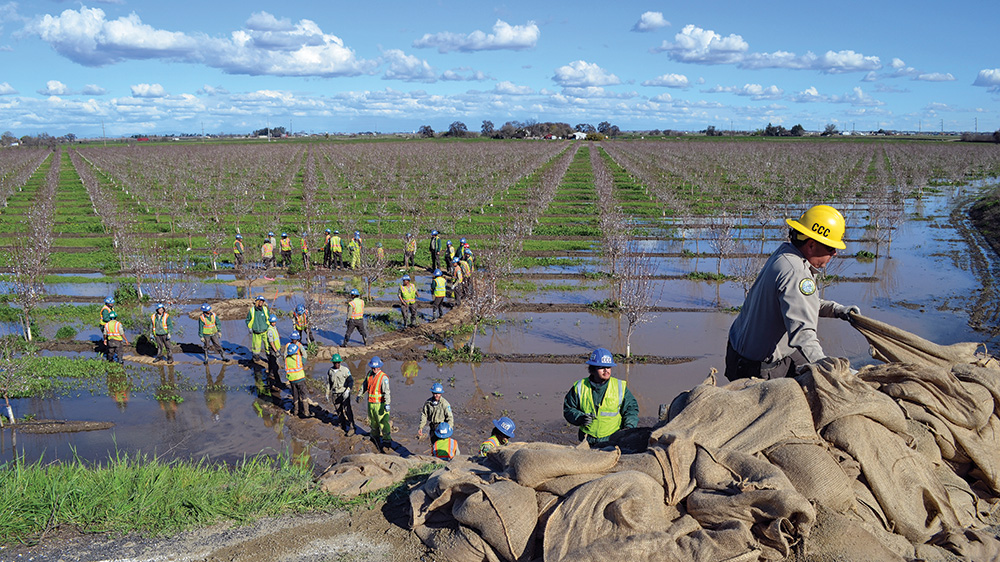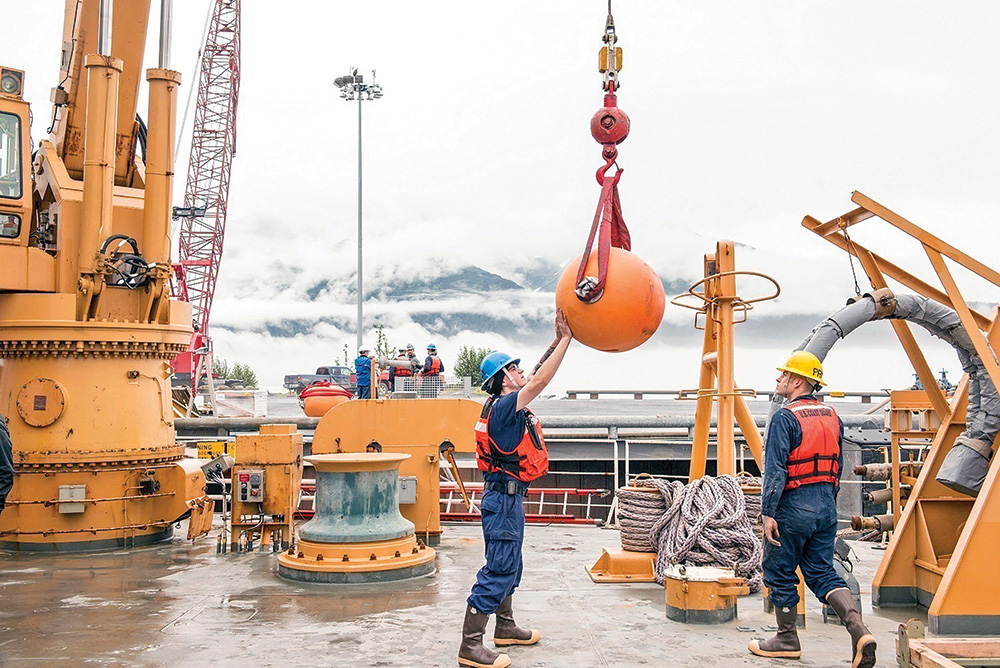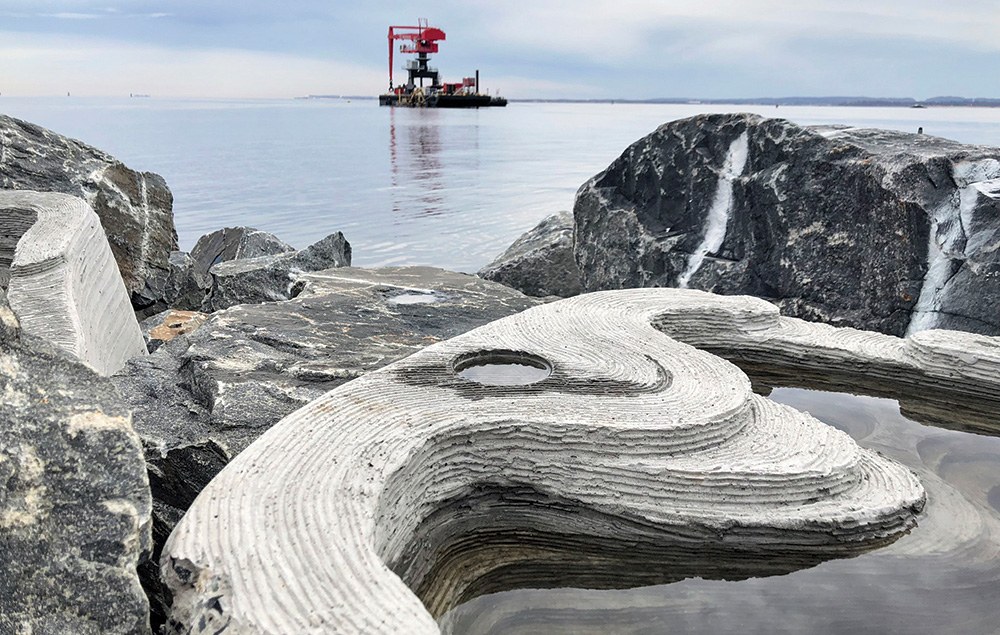Strategy 5: Ensure Adaptation at All Levels of Society
Even with improved national strategies for controlling emissions, the country will experience profound effects of global climate change.137 These burdens will fall disproportionately on marginalized communities and will have consequences beyond our borders.138 Human migrations, rearranged supply chains, altered transboundary flows of major rivers, and conflicts exacerbated by climate change will all require renewed dialogue and cooperation across communities and countries. Climate solutions will also cause worker displacements and economic shocks as industries transform. Recognizing this alignment of shared vulnerability can be a powerful incentive for building broad coalitions and overall resilience.
Effective adaptation requires engagement at every level of society. Governments, businesses, communities, and individuals all have key roles to play. And every entity or community will benefit from understanding its vulnerability and investing in adaptation.139 Proactive planning that anticipates future adaptation requirements reduces costs and exposure. Early efforts will empower learning from experience, growing expertise and making it easier to build resilience.
However, adaptation is not as well funded as mitigation, receiving only 7 percent of funds invested in climate action overall.140 In addition, because of the regional nature of many adaptation solutions, the lack of adequate funding poses significant risk of further perpetuating geographic inequities. Denser, low-income communities may lack the infrastructure, capacity, or capital required for many adaptation solutions and may need additional funding and political support. The burdens and costs of climate change solutions also weigh more heavily on those populations that have already suffered disproportionally from the effects of climate change.
Communities should consider a broad range of options for adaptation, recognizing that the viable solutions will vary by region and time. Local voices must participate in every discussion and decision about adaptation. While this report remains agnostic about the ideal adaptation strategies for any region, the Commission recognizes the advantage of choosing options that deliver cobenefits and minimize adaptation costs for any population.141
5.1 Spur increased investment in comprehensive adaptation plans through codevelopment with the federal government, states, tribes, cities, companies, and NGOs, including justice-centered voices from civil society.
Climate adaptation planning is critical for national security and efficient resource use. Without adequate planning, climate impacts will be more disruptive to critical infrastructure such as power grids, transportation systems, and communication networks.142 Climate will also have greater impacts on food and water security, which are critical for the country’s health and well-being.143
Despite the importance of these systems, few resources are devoted to city, county, state, and regional adaptation planning. Given the intricacies of preparing society for climate impacts, funding community-based plans is critical for tuning to local needs and opportunities.144 Normalizing a culture of adaptation planning will also encourage virtuous cycles of continuous improvement.
Federal funding, such as the Department of Housing and Urban Development’s National Disaster Resilience Competition grants, has effectively provided communities like those on the Ohio Creek Watershed in Norfolk, Virginia, with the resources to implement adaptation strategies to reduce flooding, improve the local economy, and strengthen neighborhood connections.145 This adaptation plan engages several players, including the city, the local community, nonprofit organizations, and architectural firms.
The federal government must mobilize the private sector to develop tools for community adaptation and resilience through public-private partnerships. Investments in green technology, such as sustainable transportation and resilient buildings, benefit both local communities and investing companies. One example is the Rockefeller Foundation’s 100 Resilient Cities Initiative, launched in 2013, which provides funding and technical assistance to cities worldwide to develop and implement resilience strategies. The initiative has also received support from private-sector partners such as Swiss Re, Microsoft, and Veolia.
5.2 Improve coordination and accessibility of existing climate resources and investments across federal agencies.
Despite several attempts, the United States remains one of the few countries that lacks a highly coordinated national adaptation strategy. Although local climate adaptation planning is crucial, coordination at the federal level is also necessary for projects that require significant capital or regional cooperation. Every federal department has responsibility for important aspects of climate change adaptation. However, the effectiveness of the policies and investments depends critically on actions by other departments, as well as states, communities, tribes, and companies.
Centralize the federal climate response and develop a comprehensive climate adaptation plan with a clear chain of command.
The White House National Climate Advisor should advance a cohesive climate adaptation plan by forming interagency working groups that will facilitate improved coordination and communication. Key to these groups will be establishing a clear chain of command for climate policy within the federal government that outlines the specific role of every agency. These working groups can also facilitate efficient and equitable distribution of funding resources and spur the creation of additional public-private partnerships.
Improve the federal strategy for prioritizing and coordinating climate investments and data.
A national strategy should include mechanisms for learning from experience, sharing promising practices, and integrating a commitment to justice. It should provide a durable but flexible road map that considers local interests and the needs of vulnerable communities. Adaptation is never one-size-fits-all, but increasing national planning, data, and project coordination is a critical starting point for efficiently allocating scarce resources. Because adaptation technologies will change and the needs of individual communities will vary over time, this strategy should include provisions for periodic assessment of the effectiveness and efficiency of climate spending.
Much of the data needed to help both the nation and local communities develop adaptation strategies already exist.146 But because of the current difficulty of navigating many sources of federal data, a central element of a national climate adaptation strategy must be the organization and provision of data. The federal government can make the data much more useful by collaborating with states and universities to establish a principal place to access climate data and promising practices. In addition, agencies need more clearly defined responsibilities for producing and validating climate data and data on adaptation science and funding opportunities.
5.3 Invest in a diverse portfolio of adaptation options, including both responses to specific threats and broad commitments to building resilience.
Adaptation to climate change will involve large social and economic disruptions. It will be hard to predict exactly which adaptation option will work best in different circumstances. Narrowing the range of options will increase costs, decrease success, and magnify the negative impacts of chosen adaptation technology for frontline communities. Some climate impacts can be prevented using approaches that have long been available, such as early-warning systems and upgraded disaster preparation and response. Other adaptation approaches are broadly acceptable but require substantial capital, including those custom designed to address local risks (such as sea walls or cooling centers) and those that support vibrant economies and ecosystems while also building future resilience. Long-term options must be more transformative to cope with climate impacts’ magnitude and disruptive nature. These will include strategies for relocation, reconstructing ecosystems, and rethinking the relationship between people and the environment.
Indigenous Knowledge
Indigenous Knowledge refers to the body of knowledge systems and practices that were developed by peoples who have been stewards of the lands and waters of the world, including those of the United States, for millennia. Partnering with Indigenous peoples on adaptation planning helps create responses to climate change that minimize harm to the surrounding environment.147 Indigenous Knowledge fills gaps in the analysis of changing weather patterns, predicts the occurrence of droughts, helps protect communities from flooding by providing local resources, and leads to the construction of more climate-resilient buildings.
Many reports, including the most recent publications by the Intergovernmental Panel on Climate Change, have explicitly recognized the many benefits and importance of using Indigenous Knowledge in climate research and responses.148 Because of the success of partnering with Indigenous people on both community acceptance and the results of adaptation projects, multiple federal agencies are intentionally seeking out partnerships with local peoples. The U.S. Geological Survey has started the Strategic Needs of Water on the Yukon (SNOWY) project, which weaves Indigenous Knowledge with hydrology to create regional adaptation plans.149 Reframing ideas through Indigenous perspectives, such as considering climate continuity, have led to changes in climate responses from researchers and local communities.150 Indigenous Knowledge also informs and improves existing policy, especially when preparing for large-scale disasters in which poor planning can exacerbate existing inequities.151 But this crucial resource is still underutilized in adaptation response, especially in the United States. Strategically increasing funding opportunities to support partnerships and learning from Indigenous practices will be necessary for protecting vulnerable peoples and ecosystems while responding to climate change.
Invest in learning and sharing promising practices for balanced adaptation strategies across communities.
While specific hazard responses and broad resilience investments can be effective, the United States will benefit most from balancing both approaches, and adjusting the balance according to community needs and circumstances. For example, a community that invests in both gray infrastructure (such as levies and sewer systems) and green infrastructure (such as restoring wetlands) may be better able to withstand floods than a community that only invests in traditional approaches.152 Similarly, investing in fire-resistant building codes and early-warning systems may offer better wildfire protection than focusing solely on thinning forests.153 Considering climate adaptation in existing infrastructure development can make resilience more cost-effective and efficient: for example, after Hurricane Katrina, builders used more resilient designs and incorporated green infrastructure in the construction of new industrial plants.154Balancing responses also reduces the negative impacts of specific hazard responses and helps prevent the most vulnerable communities from being unduly impacted.
As the correct balance of adaptation strategies is unknowable at the outset, government and philanthropy must support coordinated efforts to fund adaptation experiments and share promising practices across communities. The Kresge Foundation’s Climate Resilience and Urban Opportunity Initiative funded both direct adaptation efforts as well as learning networks for intercommunity dialogue.155 Through these networks, communities were able to share not only what combination of adaptation efforts worked well, but also strategies for implementation and evaluation.
Living Breakwaters: Using Green Infrastructure to Build Resilience
In October 2012, Hurricane Sandy devastated many coastal communities across the Northeast, including throughout Staten Island, New York. The storm and resulting flooding caused injuries and fatalities and destroyed many homes. These tragedies emphasized the extent to which decades of pollution, oyster overharvesting, and dredging had destroyed natural barriers that previously buffered much of the greater New York–New Jersey Harbor from storm surge and erosion. In collaboration with New York State and other organizations, the landscape architecture firm SCAPE developed a plan for a 1.5-mile necklace of “living breakwaters” off the South Shore of Staten Island to help reduce flood risk in the neighborhood of Tottenville, which was hit particularly hard by Sandy.156
Now under construction, the breakwaters are built of stone and biologically enhanced concrete units configured into rocky crests that reduce damaging waves and help reverse coastal erosion. Some breakwaters also feature structural modifications called “reef ridges” and “reef streets,” which introduce a mosaic of intertidal habitat space for fish, oysters, and other marine species. After construction is complete in 2024, the Billion Oyster Project, a New York–based nonprofit, will assist with oyster restoration through methods including seeding young oysters on the breakwaters and installing oyster, clam, and scallop shells recycled from New York restaurants to encourage reef growth. As the reef grows over time, it will boost the breakwaters’ ability to reduce waves, enhance water quality, and foster marine biodiversity.
The Living Breakwaters project also aims to build social cohesion onshore by engaging with and educating the local community. SCAPE and the Billion Oyster Project collaborated to develop an open-access Living Breakwaters Curriculum, which has been taught in local schools and is available online. This curriculum provides teachers with lesson plans that engage students on topics such as resilience, risk reduction, and local ecosystems, using the project as a case study for these themes. The curriculum also acknowledges that although the breakwaters reduce risk, climate change still presents continued threats to the community.
This public-private partnership demonstrates the potential for large-scale eco-system restoration in severely degraded environments and can serve as a model for similar projects at a national and global scale. When complete, Living Breakwaters will have created and strengthened marine ecosystems, reduced risk to the island’s vulnerable shoreline, and reached thousands of New Yorkers through outreach and education.
Increase incentives and requirements for considering cobenefits in adaptation planning.
The federal and state governments, community development organizations, and philanthropies should invest in strategies that consider comprehensive adaptation efforts with known cobenefits for the environment and human health and well-being. In addition to being lower cost and having high degrees of public support, investing in adaptation options with cobenefits to health and well-being advances environmental justice by addressing the underlying social determinants of health, reducing existing disparities through green infrastructure, and building social cohesion.157
Implementing these changes will require a combination of government incentives and increased regulatory requirements. Several states, such as Massachusetts and Minnesota, have adopted the Health in All Policies framework, which incentivizes funding for projects that consider the impacts of climate policies and projects on the determinants of health.158 This framework also creates accountability metrics to measure and evaluate project performance.


